WHIP - The Wye Habitat Improvement Project
WHIP officially ended on 30th June 2002 but for those of us dealing with the paper mountain, it really only finished a week or so into March 2003, when we had confirmation from WEFO that our final audit had been satisfactory and that all matters administrative and financial were satisfactorily concluded. What had been achieved since the auspicious start on April 1st 1998?
Devised by our Director in 1997 using funds from the European Agriculture and Guidance Fund (EAGGF), the scheme enabled significant amounts of habitat work to be carried out on targeted tributaries. This was the Foundation's first foray into European funding and the complexities these projects bring. Underpinning the main aim was a means of involving farmers who owned tributaries who would take advantage of improvements to their own brown trout fishing, while the principal funding parties would benefit additionally from improved salmon production. The project also aimed to market these small fisheries as part of the scheme. Approval came with a detailed list of agreed targets in such areas as job creation, advisory visits and numbers of innovative schemes and ideas created.
Up to the last world war, most of the tributaries of the Wye and Usk were rotationally coppiced. The wood extracted was used for charcoal, firewood and clogs. A collapse in demand for this sort of wood meant that most streamside trees remained unmanaged over the last sixty or more years, with multi-stemmed alder a feature of many streams.
Shading from mature trees gives rise to significant reductions of the numbers of juvenile trout and salmon a stream might otherwise be able to support. Martin O'Grady (1993) found a reduction to 18% and 22% in young trout and salmon densities in shaded streams when compared to unshaded streams. At worst, multi-stemmed trees are prone to topple over. Trunks left in the channel can deflect the flow can give rise to very extensive erosion. The loss of root systems is also likely to cause bank instability. Heavy grazing inhibits new tree growth (see pictures below) and together with the effects of shade, contrives to remove the stabilising effects of the annual bank side vegetation. Thus the essential stream structure is lost and with it, the parr territories that ultimately ensure good numbers for the next generation of salmon. Plenty of reason therefore, to re-introduce a riparian management programme.
Before work could start however, there were a number of significant logistical problems to solve. We were barely prepared for the chain of consents required to coppice trees, not to mention the concerns of those who believe conservation = doing nothing. This is how the chain went:
- Approval of a stream section by steering group >
- Owners consent sought ...and gained >
- Stream plan agreed (including IACS, ESA, Organic scheme approval where appropriate) >
- Forest design plan>
- SSSI approval >
- Section 15 agreements >
- Rights of way >
- Work Starts >
At first, we had to rely on the generosity of farmers to allow land to be fenced out of production. Later, following listing of the river system as a SSSI, Section 15 grants allowed them to be paid annually for loss of grazing. This became the vehicle by which CCW contributed to the project. Stream corridors became much wider as a result, and the problem of long-term commitment to maintenance was, from our point of view, solved: CCW part funded the coppicing and fencing and provided the essential legal agreement. The Agency agreed on a general consent for soft revetments, while they too contributed generously to the project. We were at last able to fence off, coppice and repair damaged sections of streams, ensuring farmers were compensated and that they had an interest in maintaining the improvements either through letting the fishing or via Section 15 agreements. So what did we achieve? Unquestionably one of the most important achievements was setting up the process that allowed habitats to be repaired and restored, plus seeing fish numbers significantly rise. Below is a summary of what we actually completed:
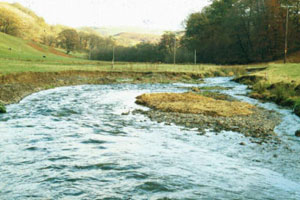
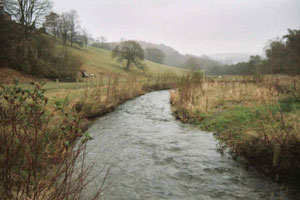
Restoration of braiding and erosion on the Clywedog, four
years later the channel has narrowed and deepened and the banks are
stable with a new growth of Alders.
1. Streams:
25km fenced and coppiced/drinkers gates revetments etc on the...
Clywedog
Edw
Duhonw
Marteg
Digedi (fish passes)
2. New techniques:
We developed new techniques for making cost effective Watergates, reveting and a way of fencing certain sections that lie within flood plains.
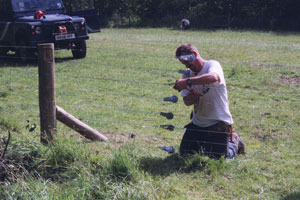
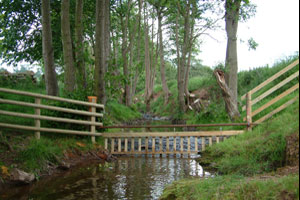
High Tensile fencing is used in flood plains. The absence
of vertical
wires prevents debris from building up and damageing the fence.
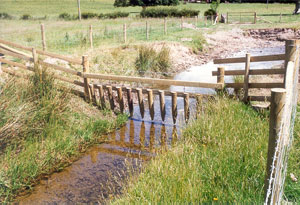
A stock proof water gate.
Note the lush growth within the fenced-off (ungrazed) area.
3. Targets
| Whip Targets | Target | Achieved |
| Jobs Created | 4 | 8 Fulltime 4 part time |
| Jobs Safeguarded | 2 | 6 |
| Trainee places provided | 80 | 81 |
| Farm business advised | 90 | 91 |
| Group activities | 10 | 25 |
| New products developed | 2 | 2 |
| % Farmers assisted under 40 | 66 | 27 |
| New/enhanced farm attractions | 30 | 29 |
| Farmers assisted under 40 | 60 | 21 |
| Trainee days provided | 60 | 73 |
4. WHIP won the Famous Grouse Wild Trout Society Award in 1999, with the Foundation's fish pass programme taking second place. In February 2001 Foot and Mouth disease (FMD) resulted in the work force being prohibited from entering farmland. Sadly we had to lay off most of the habitat team save a few key men. With little foreseeable resolution by May, our resolve to persevere resulted in work continuing on the Digedi fish passes, which fortunately could be accessed from the main road. One casualty of FMD was our marketing scheme, which went on hold to be resurrected with our next project.
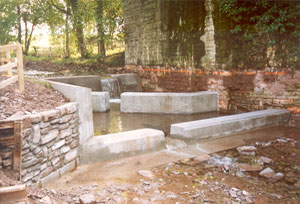
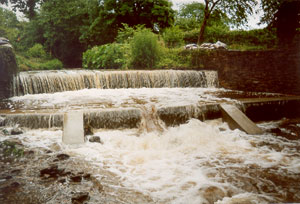
The two Digedi fish passes, built while Foot And Mouth kept us off the land.
Monitoring:
Monitoring sought to determine the changes in fish densities against the improvements generated by habitat work through a sophisticated electro fishing regimen. Robert Luxton from Cardiff University carefully monitored the changes in bank side vegetation as a result of habitat work he is just about to publish his PhD on this work. Details of these are awaited at time of going to press.
BUDGET |
||
| Whip Budget | Budget | Actual |
| Equipment .............................................. | 22,000 | 22,720 |
| Habitat Measures .................................... | 375,100 | 400,236 |
| Monitoring Costs ..................................... | 270,300 | 295,680 |
| Office/Secretarial ..................................... | 51,800 | 68,096 |
| Vehicle Running ...................................... | 41,000 | 36,483 |
| Admin/management ................................ . | 87,200 | 101,383 |
| Fees - Legal & Land Agent ...................... | 18,000 | 2,071 |
| Surveys & Access ................................... | 62,400 | 32,381 |
| Training ................................................... | 29,000 | 2,678 |
| Marketing & Publicity ............................... | 101,200 | 31,736 |
| Auditing .................................................. | 12,500 | 5,141 |
| Accountancy ........................................... | 8,000 | - |
| Bank Charges/Interest .............................. | - | 2,378 |
| Sundry Expenditure ................................... | - | 943 |
| Ineligible Expenses .................................. | - | 16838 |
| 1,078,500 | 1,018,764 | |
| Grant available up to £390,000 | ||
| Total Grant Received £355,831 | ||
| Contributions to Whip from Partners 1998 to June 2002 | ||
| Cash grants, donations and support | £ | |
| European Agricultural Guidance and Guarantee Fund ............................ | 355,830 | |
| Welsh Office Regional Development Fund ............................................ | 150,000 | |
| Game Conservancy Trust ................................................................... | 120,000 | |
| The Wye Foundation .......................................................................... | 99,110 | |
| Environment Agency .......................................................................... | 60,000 | |
| Countryside Council for Wales ............................................................ | 55,015 | |
| Severn Trent Water ............................................................................ | 5,000 | |
| Other ................................................................................................ | 2,622 | |
| Total Cash Income ............................................................................. | 847,577 | |
| In kind costs by individuals and organisations | ||
| Cardiff University ................................................................................. | 68,634 | |
| The Wye Foundation .......................................................................... | 53,151 | |
| Environment Agency ........................................................................... | 20,628 | |
| Countryside Council for Wales ............................................................ | 17,648 | |
| Radnorshire Wildlife Trust ................................................................... | 11,126 | |
| Farmers Union of Wales ...................................................................... | 0 | |
| Total in kind costs treated as donations ................................................ | 171,187 | |
| Total Income | £1,018,764 | |
Whether you think the greater achievement of WHIP is primarily 25km coppiced, fenced and repaired stream, or the establishment of method & means is surely a moot point. Until WHIP was established, habitat restoration had just been a wish list on a fisheries plan. Today, restoring our tributary streams is a reality and it started with this project.
